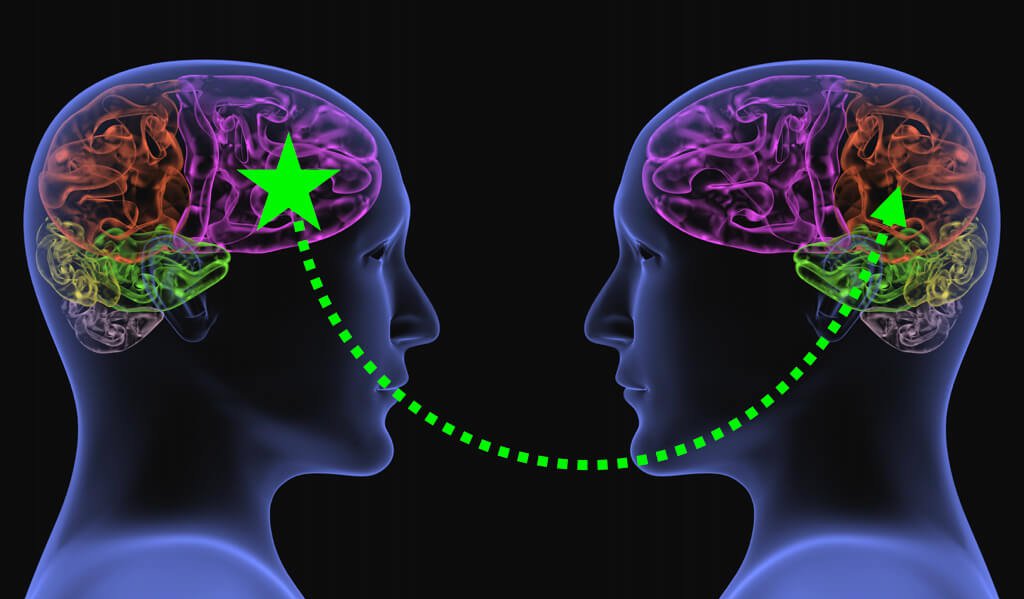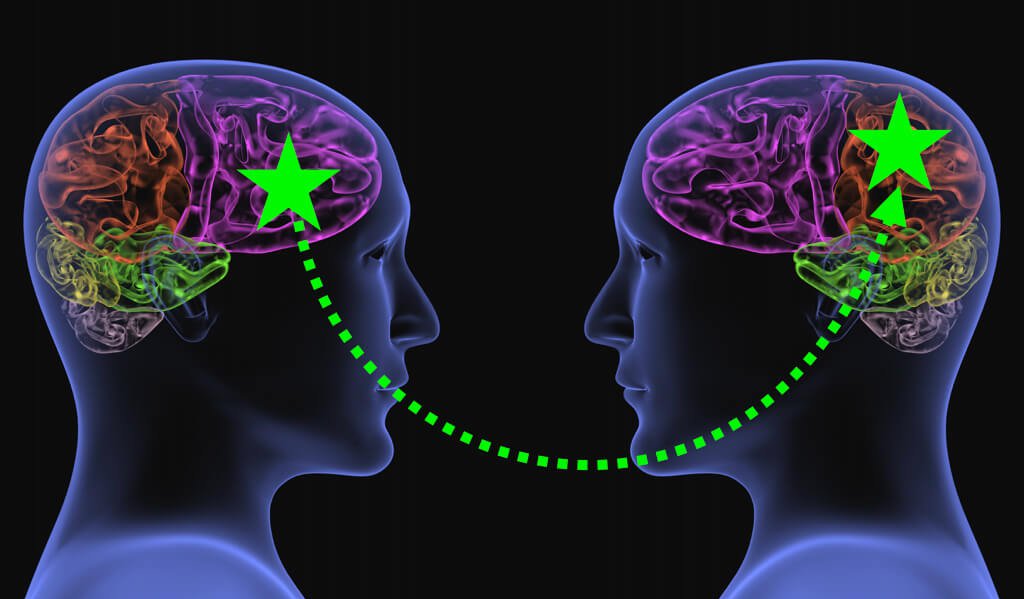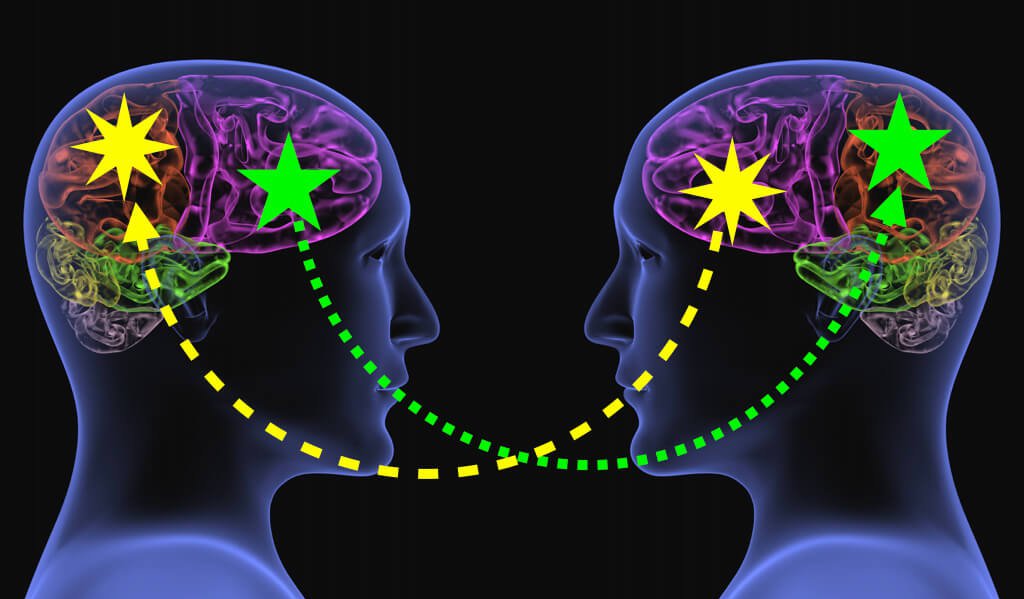In part one of this series of articles, Tony Watkins looked at the meaning of the term ‘mode’ within communication theory, and introduced the ideas of ‘semiotic resources’ and ‘affordances’.
We must consider an important question before we go any further: what is communication? Gunther Kress says that communication is more complex than we imagine. The classic model of communication goes like this:
A simplistic model of communication – 1 (image from Crestock.com)
Person A has an idea in their mind and speaks it to person B. B hears the words and the same idea forms in B’s mind exactly as it is in A’s mind.

A simplistic model of communication – 2 (image from Crestock.com)
B then replies, A hears it and has B’s idea formed in his or her mind exactly as it is in B’s mind.

A simplistic model of communication – 3 (image from Crestock.com)
This would be perfect communication. But reality is never like this. This very simplistic model focuses only on speech, and doesn’t allow for the complexity of real-life communication. It also puts the emphasis entirely on the sender of communication. If the communication fails, it suggests that the speaker is at fault for not expressing the idea clearly enough. But communication can fail for many reasons, some of which are nothing to do with the one trying to communicate.
Three fundamental assumptions
Gunther Kress has three fundamental assumptions about communication:1
1. Communication happens as a response to a prompt
Imagine the communication taking place in a hospital operating theatre.2 Several people are in the room, focusing on different aspects of the operation and communicating with each other constantly. Some of their communication will be verbal, but much of it will not be – especially in a team which has worked together on many occasions. It will include gestures, glances, and tone of voice. The senior surgeon in the operating theatre could attempt to communicate in any way he likes – he could say something or make a gesture – but if nobody else in the room pays any attention to him, he has not communicated anything. His attempt to communicate is a prompt.
Someone else needs to respond to that prompt for there to be any communication. In order to respond to the prompt, they first need to recognise that it is a prompt. A surgeon may put out a hand for a scalpel: that’s the prompt. But if the scrub nurse is looking away at that moment, the prompt goes unnoticed and no communication takes place. If the scrub nurse sees the surgeon’s hand go out, but fails to recognise that it is a prompt, no communication takes place. A good scrub nurse plays close attention to the surgeon and is constantly alert for prompts. When the communication in a context like this is really effective, the team becomes like a well-oiled machine.
You are reading this because you recognised the article as a prompt, and paid attention to it. But something else needs to happen for communication to take place.
2. Communication happens when there is an interpretation
It is not enough for the scrub nurse simply to recognise the prompt. The prompt must also be interpreted. A good scrub nurse interprets correctly and quickly. An incompetent nurse who wonders what the surgeon’s extended hand could possibly mean will soon be out of a job. When the scrub nurse has both recognised the prompt and interpreted it (whether correctly or not), communication has taken place. But until some interpretation has happened, there has been no communication. The communication is effective if the interpretation fits with what the surgeon wanted to communicate. It is ineffective if the prompt is misinterpreted.
Instagram has 75 million daily users who, between them, upload 95 million photos and videos. The vast majority of these people never communicate anything to me because I never see these prompts – I only follow a few hundred Instagram users. Even those Instagram users I do follow only communicate with me some of the time, because they inevitably post many of their photographs at times when I’m not on Instagram. When I do see someone’s post in my feed, there is a prompt for communication. But if I do not pause to pay attention to the image (I recognise the prompt but don’t bother to interpret it), there has still been no communication. Another Instagram user only communicates something to me when I see her photograph, pay attention to it, and interpret it.
Interpretation is a vital aspect of social semiotic theory, which
‘includes study of how communicators create texts3 (including the role of technology) and how people interpret texts.’You 4
We will return to this shortly.
3. Communication is always multimodal
There are not many – if any – contexts in which we use only a single mode at a time. Many text messages are still just text, but many now also include emojis, stickers, and GIFs. When we speak on the phone, we only use our voices, but now we might prefer to FaceTime or Skype people instead. We like to include additional modes when we can because it gives us the benefit of extra affordances.
Text, for example, has some affordances (clarity, precision, and low ambiguity). However, it is very difficult to communicate emotion easily. So drawing on the semiotic resources of another mode enables us to make use of more affordances, which can make up for those which text lacks. An emoji or a GIF brings in the ability to quickly communicate some emotion (whether we are making a joke, feeling frustrated, or confused, etc.).
Any website that only makes use of the mode of tex is incredibly dull. As visitors to the site, we want a richer experience so we expect a website creator to use additional modes such as image, layout, colour, video, audio, and dynamic elements.
Verbal communication over the phone has some affordances which written text doesn’t have – because of what we can communicate through tone of voice – but sometimes it’s still not enough. We then need the additional affordances of a second mode, such as gesture or facial expression, by making a FaceTime or Skype video call. We might need to add in even more modes by meeting someone face-to-face, which would enable us to draw on the affordances of a handshake or a gift.
Most of our communication, therefore, is multimodal rather than unimodal. That is, we use a combination of modes rather than just one. Gunther Kress argues that all communication is multimodal. Even a plain text message is likely to have punctuation, which adds to the affordances of the text. Or it may have line breaks in order to change the layout. Text needs a medium, too, whether electronic, paper, skin, or something else. The medium becomes another mode. Similarly, voice communication does not happen in a monotone, but includes at least a second mode – tone of voice.
A social semiotic theory of multimodal communication
Kress calls his communication theory a social semiotic theory of multimodal communication. It is a ‘social semiotic theory’ because it is to do with the use of signs within the context of social relationships (as we explored in the first article in this series).
Social semiotics is an approach to communication that seeks to understand how people communicate by a variety of means in particular social settings.5
It is a ‘theory of multimodal communication’ because all communication uses more than a single mode, and most combines modes in order to give us the affordances that we require.
Initiator and recipient
The two partners in communication (leaving aside for a while the additional complications of communicating to multiple people) are the initiator and the recipient. Kress sees the initiator as having two functions: as ‘rhetor’ and ‘designer’. The rhetor (from ‘rhetoric’) aspect is about deciding what concepts are to be communicated, whereas the designer aspect is about finding the best way of communicating the concepts.
The initiator’s perspective
The initiator must consider:
- ‘the social relations with the audience’: For example, a group of friends communicating with each other, a congregation in a church listening to its pastor, or the unknown readers of an article reading the words of its writer. These all entail different social relations, and an initiator would need to find different ways of communicating in each case.
- ‘the fit of modes, audience and message’: What modes will work best for this audience and this message?
- ‘the fit of the materiality of mode with the phenomenon to be represented and communicated’: That is, what is the best form of mode, given what is being communicated?6
Kress draws a crucial distinction between representation and communication. Representation is entirely focused on me (the initiator) and my interests; communication is focused on the audience (the recipients), and their interests and needs.
Many self-published books are examples of representation rather than communication. The author wants to set out their knowledge and ideas about a particular subject, often in great detail, and imagines that others will want to read it. They self-publish their book, without having had it edited or designed by professionals, and then wonder why no one reads it. Such a book is an exercise in indulging the author’s interests – it is only representation of the authors ideas. If the author had any concern for his audience, he would work hard to make the subject relevant, interesting, and engaging for that audience – it would be real communication.
This is not just good communication theory; this should be a fundamental value for all Christian communicators. The apostle Paul wrote:
When you do things, do not let selfishness or pride be your guide. Instead, be humble and give more honor to others than to yourselves. Do not be interested only in your own life, but be interested in the lives of others. (Philippians 2:3–4, CEV)
It is not that our interests don’t matter, but that we need to value others’ interests above our own. Communication, rather than representation, happens when we find a way to connect our interests with that of the audience. Representation creates prompts on a take-it-or-leave-it basis, which are easily ignored. Communication creates prompts that the audience wants to attend to. Communication is about the relationship between the initiator and the recipient.
This advert from Apple is a brilliant example of a company communicating in a way which is deeply aware of the interests, desires, and needs of its audience.
Apple fans are not just interested in what the technology does, but in the way that it does it, in the design and style, etc. – and Apple is (or at least was) very aware of that. They are interested, according to the advert, in the experience of a product and how it make someone feel. All communicators should be just as aware of the experience of the end-user (the audience) and how it makes them feel. Christian communicators are sometimes so concerned to get their message out that they ignore how the audience is responding to it. We easily slip into representation, not communication – and that is a failure to love our audience.
Communication theory tends to be academic, and a ‘social semiotic theory of multimodal communication’ is difficult to communicate simply. But there are important ideas for Christian communicators here, so I have worked hard to communicate it as clearly, helpfully, and engagingly as possible. It is for you to judge whether or not I have succeeded! I believe that thinking seriously about these issues will enhance your communication. Your interests as recipients, therefore, match up with mine as initiator. I’m convinced that it matters because we are not communicating trivia, but the life-transforming good news of Jesus Christ. Nothing is more important than this, and central to our communication of the gospel must be communication – connecting our interests with the interests of our audience. We need love for those to whom we are communicating.
The recipient’s perspective
As Kress says, communication does not happen if the recipient does not engage with the message. A recipient must respond to the prompt, and then interpret the message. The recipient is also an interpreter. Kress says:
An interpretation is a response to a prior prompt. The characteristics, the ‘shape’ of that prompt, constitute the ‘ground’ on which the interpretation happens. . . . Because interpretation is central, so therefore is the interpreter; without interpretation there is no communication. 7
For this series of articles, I assembled my ideas and quotes, write my text and found images and videos, then I put all that into pages within this website, paying attention to layout and so on. I shaped all of it into a prompt for you as the potential recipients. By putting it online, I offer it to you as a prompt, and that combination of elements (in various modes) is the ground on which you do your interpretation. All of you will do something different with it, because each of you will interpret it in a somewhat different way. How you interpret it depends on your background, education, personality, context, and other aspects of your interests. I’ve set the same ground for every reader, but each reader’s response – each person’s interpretive work – is unique.
Having responded to a prompt, and done interpretive work on the message, the recipient may re-shape the concept into a new prompt for another audience. They set a new ground for someone else.
We will consider these processes more in the next article in this series.
Share this Post
Photo credits (from top):
© Alejandro Escamilla (Unsplash), used under a Creative Commons licence.
Crestock.com.
© Andy G. Used under a Creative Commons (CC-BY-SA-2.0) licence.
© Rubin Starset. Used under a Creative Commons (CC-BY-NC-SA-2.0) licence.
© Tastwo, used under a Creative Commons CC-BY-NC-ND-2.0) licence.




